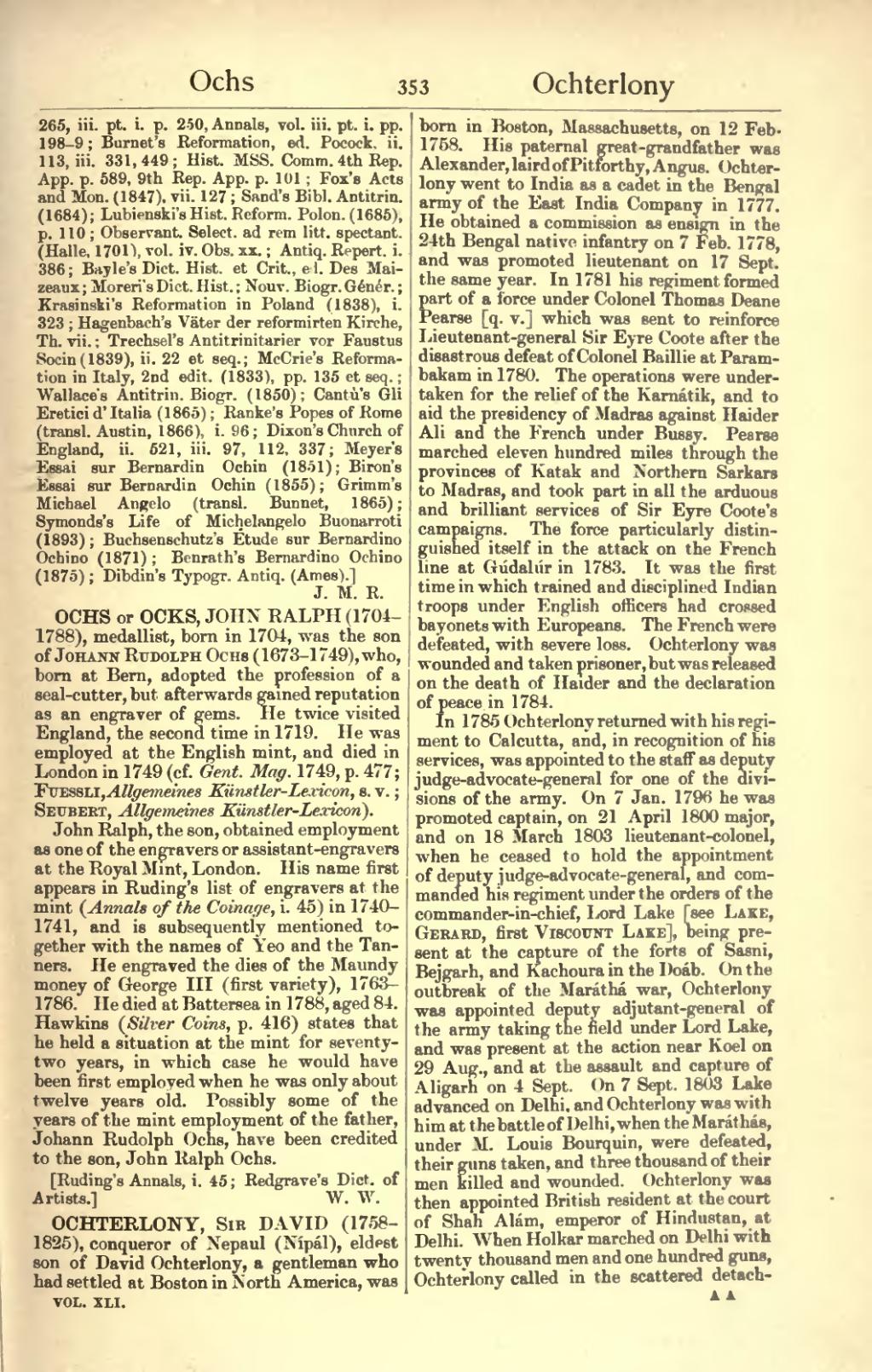OCHS or OCKS, JOHN RALPH (1704–1788), medallist, born in 1704, was the son of Johann Rudolph Ochs (1673–1749), who, born at Bern, adopted the profession of a seal-cutter, but afterwards gained reputation as an engraver of gems. He twice visited England, the second time in 1719. He was employed at the English mint, and died in London in 1749 (cf. Gent. Mag. 1749, p. 477; Fuessli, Allgemeines Künstler-Lexicon, s. v.; Seubert, Allgemeines Künstler-Lexicon).
John Ralph, the son, obtained employment as one of the engravers or assistant-engravers at the Royal Mint, London. His name first appears in Ruding's list of engravers at the mint (Annals of the Coinage, i. 45) in 1740–1741, and is subsequently mentioned together with the names of Yeo and the Tanners. He engraved the dies of the Maundy money of George III (first variety), 1763–1786. He died at Battersea in 1788, aged 84. Hawkins (Silver Coins, p. 416) states that he held a situation at the mint for seventy-two years, in which case he would have been first employed when he was only about twelve years old. Possibly some of the years of the mint employment of the father, Johann Rudolph Ochs, have been credited to the son, John Ralph Ochs.
[Ruding's Annals, i. 45; Redgrave's Dict. of Artists.]
OCHTERLONY, Sir DAVID (1758–1825), conqueror of Nepaul (Nípál), eldest son of David Ochterlony, a gentleman who had settled at Boston in North America, was born in Boston, Massachusetts, on 12 Feb. 1758. His paternal great-grandfather was Alexander, laird of Pitforthy, Angus. Ochterlony went to India as a cadet in the Bengal army of the East India Company in 1777. He obtained a commission as ensign in the 24th Bengal native infantry on 7 Feb. 1778, and was promoted lieutenant on 17 Sept. the same year. In 1781 his regiment formed part of a force under Colonel Thomas Deane Pearse [q. v.] which was sent to reinforce Lieutenant-general Sir Eyre Coote after the disastrous defeat of Colonel Baillie at Parambakam in 1780. The operations were undertaken for the relief of the Karnátik, and to aid the presidency of Madras against Haider Ali and the French under Bussy. Pearse marched eleven hundred miles through the provinces of Katak and Northern Sarkars to Madras, and took part in all the arduous and brilliant services of Sir Eyre Coote's campaigns. The force particularly distinguished itself in the attack on the French line at Gúdalúr in 1783. It was the first time in which trained and disciplined Indian troops under English officers had crossed bayonets with Europeans. The French were defeated, with severe loss. Ochterlony was wounded and taken prisoner, but was released on the death of Haider and the declaration of peace in 1784.
In 1785 Ochterlony returned with his regiment to Calcutta, and, in recognition of his services, was appointed to the staff as deputy judge-advocate-general for one of the divisions of the army. On 7 Jan. 1796 he was promoted captain, on 21 April 1800 major, and on 18 March 1803 lieutenant-colonel, when he ceased to hold the appointment of deputy judge-advocate-general, and commanded his regiment under the orders of the commander-in-chief, Lord Lake [see Lake, Gerard, first Viscount Lake], being present at the capture of the forts of Sasni, Bejgarh, and Kachoura in the Doáb. On the outbreak of the Maráthá war, Ochterlony was appointed deputy adjutant-general of the army taking the field under Lord Lake, and was present at the action near Koel on 29 Aug., and at the assault and capture of Aligarh on 4 Sept. On 7 Sept. 1803 Lake advanced on Delhi, and Ochterlony was with him at the battle of Delhi, when the Maráthás, under M. Louis Bourquin, were defeated, their guns taken, and three thousand of their men killed and wounded. Ochterlony was then appointed British resident at the court of Shah Alám, emperor of Hindustan, at Delhi. When Holkar marched on Delhi with twenty thousand men and one hundred guns, Ochterlony called in the scattered detach-
